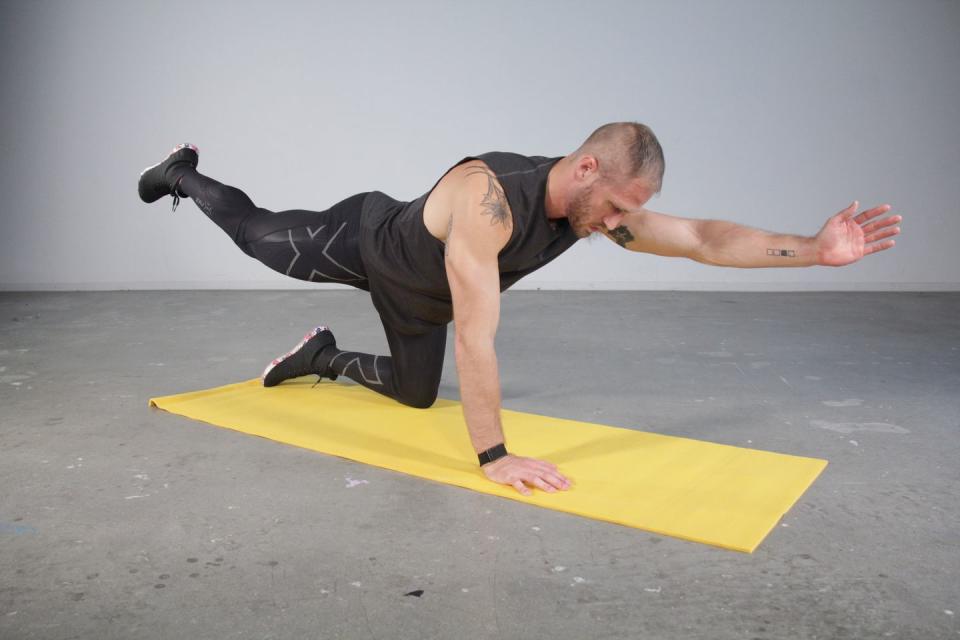How to Do a Bird Dog Without Wasting Your Time
Core training might be one of the most misunderstood pursuits in the gym. The classic ab workout most guys turn to consists of crunches, situps, maybe some leg lifts, all movements that require you to bend at the waist. In trainer speak, they're exercises that use your core's ability to flex your spine. The problem is, your core is capable of much more than that—so if you want a well-rounded workout that challenges the muscle group in more ways than just one, you'll want to include a wider array of exercises, like the underrated bird dog.
The bird dog might look underwhelming, especially if you're not well-versed in how your abs actually work. Unlike other common ab-training exercises, you're not on your back, and if you rush through the movements quickly, you're going to have a hard time staying on task. The bird dog is all about maintaining solid posture and owning your balance and stability.
In order to make the most of the movement, you're going to need to understand why you're doing the bird dog, along with how to make sure you're not shortchanging yourself with sloppy form. Here, Men's Health fitness director Ebenezer Samuel, C.S.C.S. and fitness editor Brett Williams NASM-CPT break down everything you need to know. The biggest key to the move? Maintaining total body tension and complete control of the core, says Samuel.
Benefits of the Bird Dog
The bird dog requires that you challenge some of the other functions of your core. Like the standard plank, the bird dog requires you to brace your core muscles to keep your spine straight. Once you start moving your arms and legs, however, you'll be fighting to stay in position, keeping your shoulders and hips from dipping. That's anti-rotation.
The bird dog trains your core muscles through bracing and anti-rotation, but you also have to concentrate on your movements to keep your arms and legs coordinated. To a lesser degree, you also have to engage your glutes and shoulders to keep your limbs elevated; this makes the bird dog a low-key solid move to help improve shoulder and hip mobility, too.

How to Do the Bird Dog
●Start in a quadruped position (on all fours). Your wrists should be stacked directly beneath your shoulders. Move your knees so that they're on the same plane as your wrists, giving yourself a wide base to work.
●Look straight down at the ground (you'll continue this throughout the whole movement. This allows you to maintain a neutral spine.
●Squeeze your shoulder blades together to create tension, then squeeze your abs to set your ribs. Your spine should be straight, not rounded.
●Extend one arm straight out, keeping it in line with your torso. At the same time, squeeze your glutes to raise the opposite leg. Pause for a count at the top, maintaining tension to keep your shoulders or hips from dropping. Lower your limbs down under control.
●Repeat on the movement with the opposite arm and leg.
Dive in deeper on the finer points of the exercise with these tips from Samuel.
Get Your Glutes Firing
Eb says: Unlike a plank, which has less direct glute engagement, the bird dog makes your body's biggest muscle one of the key players. When you lift up your leg, you have two choices: you can just hold it aloft, making sure to keep your foot off the floor; or you can raise your leg and squeeze the glute as hard as you can. Pick the second option to make the bird dog worth your while. Keeping your glutes engaged helps to keep your body balanced, which is the most important aspect of the movement.
Be Intentional
Eb says: It's not hard to do a bird dog: Get on all fours, raise opposite arm and leg, lower, blah blah. But the bird dog is at its best when you're intentional and very focused on every movement. Focus on keeping your torso fully parallel to the ground, hips and shoulders always square.
Doing so will require complete core engagement for the life of the bird dog. If you're having trouble learning that, step through each limb's movement in the bird dog before doing the full move (and even if you've done the bird dog before, this can be a nice refresher course in how to fire up your core properly).
Reach
Eb says: You're not just lifting your arm and leg off the ground and tightening your core. The bird dog is also a unique effective way to generate both shoulder and hip mobility—if you stretch your arm and leg out. Lift your arm up, then reach out as far as possible (while still keeping your hips and shoulders square). Lift your back leg up and extend it behind you, again reaching back as far as possible. Reaching your leg behind you in particular has benefit, gently stretching your back extensors.
Look Down
Eb says: You may be tempted to look straight ahead when doing a bird dog, but don't do that. Instead, look directly at your mat, keeping your head (and neck) in a nice neutral position. This will prevent your back from arching, keeping any stress off your lower back.
When to Do the Bird Dog
The bird dog can be both a dedicated core training movement or a general warmup exercise to prep your body—particularly your core, shoulders and hips—before a workout. You can also use the bird dog as a standalone movement to combat stiffness and poor posture, particularly if you spend a lot of time seated at a desk. Try doing 3 sets of 8 to 10 reps.
Want to master even more moves? Check out our entire Form Check series.
You Might Also Like

